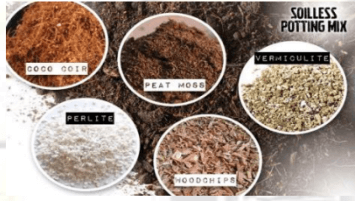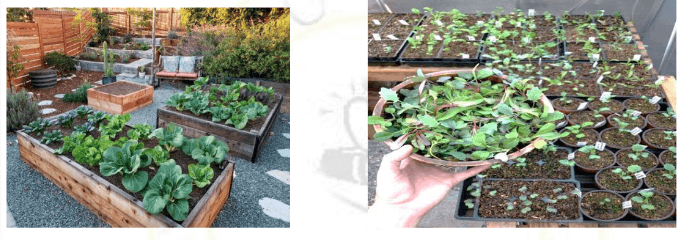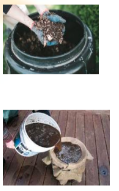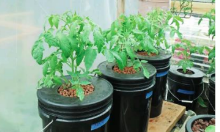
Organic Gardening Of Legumes.
Legumes include:
- Pigeon peas.
- Common beans
- Dolichos lablab beans
- Green grams
- Groundnuts
- cowpeas
- The roots of legumes have small swellings called root nodules where some very tiny living things called nitrogen fixing bacteria live.
- These bacteria take up nitrogen from the atmosphere and convert it into
- The nutrients are the absorbed by the legume crops to make proteins.
Meaning Of Organic Gardening.
- Organic gardening refers to a system of growing crops using natural farming techniques and materials instead of artificial chemicals.
- In organic gardening, compost, compost manure and animal manures are used instead of artificial fertilizers
- The organic manures feed the soil which in turn feeds the crops with nutrients leading to strong and healthy crops.
- Healthy crops are able to tolerate the effects of drought, pests and diseases which are the main causes of low yields.
- Organic manure enables the soil to hold enough moisture for crop growth.
- In organic gardening, artificial chemicals such as pesticides are not used.
- Chemicals also cause harm to animals including beneficial insects that feed on pests or those that pollinate our crops.
Establishing a legume crop.
- Proper seedbed preparation helps to remove weeds and loosen the soil for easy sowing of seeds.
- Organic manures should be incorporated into the soil during seedbed preparation.
- Seeds for planting should be healthy, whole and dry.
- The selected seed should also be suited to the climate and soil of a given place.
- Green grams, cow peas and pigeon grow well in semi-arid areas because they are drought resistant.
- Garden peas require cool and moist areas.
- To ensure seeds germinate with ease, it is important to show seeds at proper planting depth. I.e. between 2.5 cm to 10cm.
- Two to three seeds can be planted per hole using correct spacing.
- Proper spacing ensures that the crops receive adequate nutrients, water, sunlight and air for proper growth.
Caring for growing legume crops
- Irrigation if there is no rainfall
- Waterlogged seedbed should be avoided
- Application of water directly on the leaves should be avoided.
- Mulching should be done to retain moisture
- Gapping to replace the seedlings which fail to germinate.
- Thinning to remove excess seedlings.
- Correct number of plants per hole to reduce competition for nutrients, water and light
- Pests should be regularly controlled using the appropriate methods. i.e. by:
- Hand picking
- spraying
- Infected crops by diseases should be uprooted and then destroyed by burning.
- Weeding during raining season should be avoided to prevent rapid spread of diseases
- Climbing legume crops should be supported to grow upright. .
Right stage of harvesting.
- Some legumes are harvested while green and eaten as vegetable such as beans
- and Some are left to dry and harvested when they have lost their green colour. peas
- Mature legume pods turn brown and dry
- To determine when groundnuts are mature a few plants are lifted to observe the pods before harvesting all the groundnuts
- Harvesting should be done during dry weather conditions.

Innovative Ornamental Gardening
- Ornamental gardening refers to cultivation of planting with the aim of enhancing beauty of a place or landscape.
- Some crops can also be grown in a pattern that can make our surroundings beautiful
- Ornamental cropping can be done in . learning institution, hospitals, hotels, public parks, homes and sports fields
- Innovative ornamental patterns can also be made by using plants in containers or on the ground.
- The plants used could be flowers, trees, shrubs or food crops such as sugarcane, bananas, fruit crops or vegetables.
- When food crops are used for ornamental gardening, they bring beauty and also contribute to food security.
Growing Media For Ornamental Crops
- Ornamental plants can be established in two ways:
- Using soil as a base to support the roots of ornamental plants.
- Using soilless media as a base to support the roots of the ornamental
- The surface on which plants grow is called plants growing medium.
- Soil is a natural growing medium for plants
- Soilless medium can also be used to establish ornamental crops
- The nutrients can be supplied from liquid manure (called compost tea) when soilless medium is used.
Note: Compost tea is organic compost manure mixed with water.
Some of the medium for growing ornamental crops include:
- Peat moss
- Coco peat
- Sand
- Gravel

Establishing ornamental plants in soilless media.
- Identify a soilless media to use in a container.
- Measure the quantity of the soilless medium that can fill about three quarter of each available container
- Put the identified soilless medium in a container or containers.
- Add some water to moisten the soilless medium.
- Plant an ornamental plant or crop of your choice in the container garden(s)
- Select a suitable site and place your container garden in a pattern that suites your preference
- Apply liquid manure or compost tea around the base of ornamental plants from time to supply nutrients.
Preparing Compost Tea
Tools
- Two 20 litres buckets
- Clean fresh water
- Organic manure
- Stick for stirring
- strainer
Steps
- Scoop organic manure in an empty 20 litre bucket up to a third of the bucket
- Add clean fresh water(not chlorinated, rain water the best) to fill the bucket and stir with a stick
- Set aside the mixture to brew for 12 to 36 hours away from direct sunlight.
- Strain the compost using a clean piece of cloth return the leftover to a compost bin or use in the plant as mulch.
- Dilute the mixture in the ratio of 1:3 only if it is very dark in colour
Note:
- The volume of water should be twice that of liquid manure
- Do not use unfinished compost in your compost tea. Unfinished tea may contain living things that could damage plants
- Use the compost tea once a week to avoid scorching of plants.
Importance of innovative ornamental cropping.
- Beautify the environment
- Source of food
- Supply fresh air for human beings and other animals.
- Can be used as beautiful photograph background when taking photograph.
- Some act as windbreakers hence less destruction of built environment.
- Require less space.

Moisture Bed Gardening
How To Prepare A Raised Moisture Bed
Tools and Materials.
- Topsoil
- Compost manure or farmyard manure
- Dry grass
- Kitchen wastes
- Gravel
- Fork jembe
- Wooden pegs
- Ten 90cm long fitos
- A panga
- Claw harmer
- A thick polythene
Steps.
- Select a suitable site for your garden and clear any vegetation on it.
- Measure the land on the ground so that it is 1m wide and desired length.
- Fix 90cm long wooden stakes about 30cm below the ground along the edges of the marked areas.
- Inside the framework created by the stakes, lay thick polythene sheet on the ground.
- Lay a 30cm layer of hard-core or gravel carefully at the bottom
- Place a 10cm layer of dry grass or kitchen waste such as fruit and vegetable peels on top of the gravel
- Add a 20cm layer of topsoil mixed with compost manure
- Your raised moisture bed is now ready for crop establishment.
Note: You can obtain the topsoil from another place or dig out the topsoil from the same site before laying the polythene sheet.
Taking care of the crop on moisture bed.
- There is constant production of crops throughout the year.
- Soil is full of organic manure
- Many crops can be planted on a small area leading to high yields
- Some crops that don’t do well in a normal environment can be established here
- There is high water retention.

Join our whatsapp group for latest updates
Tap Here to Download for 30/-
Get on WhatsApp for 30/-
Download Gardening Practices - Agriculture CBC Grade 6 Notes.
Tap Here to Download for 30/-
Get on WhatsApp for 30/-
Why download?
- ✔ To read offline at any time.
- ✔ To Print at your convenience
- ✔ Share Easily with Friends / Students







